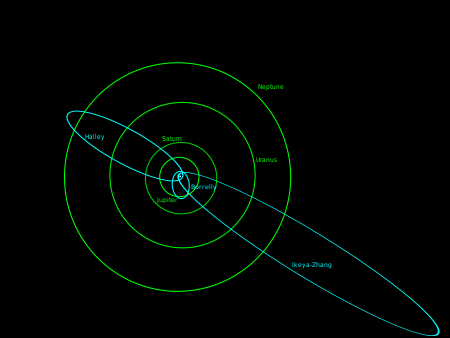astro.wikisort.org - Comet
Comet Ikeya–Zhang (Japanese, Chinese: 池谷-張彗星, officially designated 153P/Ikeya–Zhang) is a comet discovered independently by two astronomers from Japan and China in 2002. It has by far the longest orbital period of the numbered periodic comets.
 Ikeya–Zhang on April 1, 2002 | |
| Discovery | |
|---|---|
| Discovered by | Kaoru Ikeya, Zhang Daqing |
| Discovery date | February 1, 2002 |
| Alternative designations | C/2002 C1, C/1661 C1 |
| Orbital characteristics A | |
| Epoch | October 13, 2002 |
| Aphelion | 101.92 AU |
| Perihelion | 0.50714 AU |
| Semi-major axis | 51.213 AU |
| Eccentricity | 0.99009 |
| Orbital period | 366.51 yr[1] |
| Max. orbital speed | 59 km/s (2002) |
| Min. orbital speed | 0.29 km/s[lower-alpha 1] (2182-Nov-24) |
| Inclination | 28.119° |
| Last perihelion | March 18, 2002[1][2] January 29, 1661[3] |
| Next perihelion | September 1, 2362[3] 2363-Mar-14[4] |
On February 1, 2002, Chinese astronomer Zhang Daqing from Kaifeng discovered a new comet in the constellation Cetus, and reported it to the IAU. He found that Japanese astronomer Kaoru Ikeya had discovered it earlier than he had, as the time of sunset is earlier than China. According to tradition, since they discovered the new comet independently, the comet was named after both of them. The comet was initially designated as C/2002 C1 (Ikeya–Zhang).
The comet was observed in 1661, 341 years earlier, by Polish astronomer Johannes Hevelius.[5] A bright comet had also been recorded by Chinese astronomers in 1661.
The permanent designation "153P" was given to the comet. It has the longest known orbital period of any periodic comet (366.51 years). Its orbital speed around the Sun varies from 59 km/s at perihelion to 0.29 km/s at aphelion.[lower-alpha 1]
The comet passed perihelion on March 18, 2002, and with apparent magnitude 3.5, it became the brightest comet since 1997. With a multi-hundred year orbit involving asymmetric outgassing the next perihelion passage is expected between 2362–2363.

See also
- Johannes Hevelius
- List of Solar System objects by greatest aphelion
Notes
- v = 42.1219 √1/r − 0.5/a, where r is the distance from the Sun, and a is the major semi-axis.
References
- "JPL Small-Body Database Browser: 153P/Ikeya–Zhang". Jet Propulsion Laboratory. Retrieved 2011-04-20.
2002-10-02 last obs (arc 341.6 yr)
- "153P/Ikeya-Zhang Orbit". Minor Planet Center.
- Syuichi Nakano (2002-08-13). "153P/Ikeya-Zhang". OAA Computing and Minor Planet Sections. Retrieved 2009-10-04.
- "Horizons Batch for 153P/Ikeya–Zhang (90001064) on 2363-Mar-14" (Perihelion occurs when rdot flips from negative to positive). JPL Horizons. Retrieved 2021-04-10. (JPL#74/Soln.date: 2020-Jun-17)
- Green, D. (2004). "Assessment of early-modern observations of comets and supernovae: Focus on pre-telescopic European astrometric and physical data" (PDF). Durham theses. Durham University. pp. 213–228.
External links
- Orbital simulation from JPL (Java) / Horizons Ephemeris
- 153P/Ikeya–Zhang (2002)
На других языках
[de] 153P/Ikeya-Zhang
Der Komet 153P/Ikeya-Zhang wurde im Jahre 2002 von zwei unabhängig agierenden Astronomen entdeckt. Der chinesische Astronom Zhang Daqing entdeckte am 1. Februar 2002 im Sternbild Walfisch einen neuen Kometen, was er der IAU meldete. Jedoch entdeckte der japanische Astronom Kaoru Ikeya den Kometen anderthalb Stunden früher, da in Japan die Sonne früher untergeht als in der Volksrepublik China. Da aber die beiden Beobachter unabhängig voneinander innerhalb von 24 Stunden den Kometen entdeckten, erhielt der Komet die anfängliche Bezeichnung C/2002 C1 Ikeya-Zhang.- [en] 153P/Ikeya–Zhang
[ru] 153P/Икэя — Чжана
Комета Икэя — Чжана (153P/Ikeya-Zhang) — периодическая комета, которая была независимо обнаружена 1 февраля 2002 года японским астрономом Каору Икэя, а спустя полтора часа китайским астрономом Дацином Чжаном в созвездии Цефея. Она была описана как диффузный объект яркостью до 8,5 m звёздной величины и слабой комой, до 3 ' угловых минут в поперечнике. Чуть позже об открытии кометы сообщил бразильский астроном Пауло Раймундо, наблюдавший её в свой 25-сантиметровый рефлектор, но он в список первооткрывателей уже не попал.Другой контент может иметь иную лицензию. Перед использованием материалов сайта WikiSort.org внимательно изучите правила лицензирования конкретных элементов наполнения сайта.
WikiSort.org - проект по пересортировке и дополнению контента Википедии

